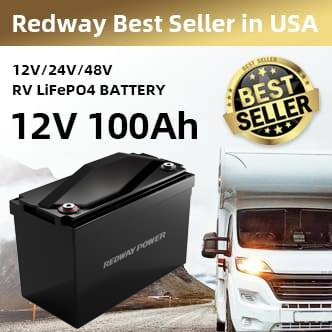Selecting the correct voltage and capacity for your golf cart battery is essential for achieving reliable performance, extended battery life, and efficient operation. By understanding your golf cart’s electrical requirements, usage patterns, terrain, and load, you can make informed decisions about battery type and configuration, ensuring maximum efficiency and durability with solutions from trusted providers like Redway Battery.
How Do I Determine the Optimal Voltage for My Golf Cart?
Golf carts typically use 36V or 48V systems. Choosing the correct voltage depends on your cart’s design, motor compatibility, and intended usage.
-
36V Systems: Created using three 12V batteries in series or six 6V batteries. Suitable for standard flat-terrain usage with moderate speed requirements, balancing performance and cost.
-
48V Systems: Created using four 12V batteries or eight 6V batteries in series. Offers higher efficiency, better performance on hilly terrain, and increased speed and torque.
To select the right system, check your golf cart’s manufacturer specifications and existing battery setup. Ensuring compatibility with your cart’s motor and controller is critical to avoid damage and optimize performance.
Wholesale lithium golf cart batteries with 10-year life? Check here.
| Voltage System | Battery Configuration | Ideal Use Case |
|---|---|---|
| 36V | 3×12V or 6×6V | Flat terrain, light loads, short trips |
| 48V | 4×12V or 8×6V | Moderate hills, heavier loads, longer trips |
How Can I Determine the Required Battery Capacity?
Battery capacity, measured in amp-hours (Ah), determines how long your golf cart can operate before recharging. Consider the following:
-
Usage Duration: Multiply your average current draw by daily hours of operation. For example, a 20A draw over 4 hours requires at least 80Ah (20A × 4h).
-
Terrain and Load: Hilly terrain or heavier loads increase energy consumption, requiring higher capacity.
-
Reserve Capacity: Choose a slightly higher Ah than your calculations to prevent deep discharges that shorten battery life.
| Use Case | Recommended Capacity |
|---|---|
| Light use / flat terrain | 60–100 Ah |
| Moderate / hilly terrain, 4 passengers | 90–120 Ah |
| Heavy use, long range, 6 passengers | 150+ Ah |
What Are the Steps to Calculate Total Energy Needs?
Total energy (in watt-hours) indicates how much energy your battery provides per charge. Use the formula:
Want OEM lithium forklift batteries at wholesale prices? Check here.
Total Energy (Wh) = Voltage (V) × Capacity (Ah)
For a 36V system with an 80Ah battery:
36V × 80Ah = 2880Wh
This helps estimate how far your golf cart can travel on a single charge and informs the selection of batteries that match your operational requirements.
Which Battery Type Should I Choose for Optimal Performance?
Selecting between lead-acid and LiFePO4 batteries affects performance, lifespan, and maintenance.
-
Lead-Acid Batteries: Affordable and widely available, but heavier, require maintenance, and typically last 300–1,000 cycles.
-
LiFePO4 Batteries: Lighter, maintenance-free, and durable with 3,000+ cycles. Offer consistent power under high loads, better temperature tolerance, and faster charging.
Redway Battery specializes in LiFePO4 solutions that maximize longevity and efficiency, providing reliable performance for demanding applications like golf carts and forklifts.
| Feature | Lead-Acid | LiFePO4 (Redway Battery) |
|---|---|---|
| Lifespan | 3–5 years | 8–10+ years |
| Maintenance | High | Minimal |
| Weight | Heavy | 50–70% lighter |
| Charging Time | 8–12 hours | 2–4 hours |
| Performance Consistency | Decreases | Stable throughout cycle |
What Practical Considerations Should I Keep in Mind?
When selecting batteries, consider:
-
Charging Infrastructure: Ensure chargers are compatible with your voltage and battery chemistry. LiFePO4 batteries, like those from Redway Battery, often require specialized chargers.
-
Temperature Effects: LiFePO4 batteries perform well across a wider temperature range compared to lead-acid.
-
Space and Weight: Lighter, compact batteries allow easier installation and can improve overall cart performance.
Redway Expert Views
“Choosing the right battery for a golf cart involves more than just voltage and capacity—it’s about matching energy storage to operational demands and environmental conditions. LiFePO4 batteries offer a strategic advantage due to their longevity, consistent power delivery, and low maintenance. At Redway Battery, we focus on delivering OEM-quality solutions tailored to each client’s usage patterns, ensuring every golf cart operates efficiently and reliably over years of service.”
How Should I Conclude My Battery Selection Process?
To ensure optimal golf cart performance:
-
Verify your cart’s voltage and motor compatibility.
-
Estimate energy requirements considering load, terrain, and daily usage.
-
Choose a high-quality battery chemistry such as LiFePO4 for long-term durability.
-
Factor in charger compatibility, temperature, and space constraints.
Working with Redway Battery guarantees professional guidance and access to reliable, high-performance LiFePO4 battery packs.
FAQs
What voltage is best for a golf cart?
Most carts operate efficiently between 36V and 48V. Choose 36V for flat terrain and lighter loads; 48V is ideal for heavier loads and hilly terrain.
How long will a golf cart run on a single charge?
It depends on the battery’s amp-hour rating, voltage, load, and terrain. For example, an 80Ah, 36V battery provides approximately 2880Wh of energy.
Are LiFePO4 batteries worth the investment?
Yes. They offer longer lifespan, lower maintenance, consistent performance, and faster charging, making them cost-effective over time.
Can I upgrade a 36V golf cart to 48V?
Upgrading requires checking motor and controller compatibility, as higher voltage increases performance but may stress existing components.
How do I know my battery is fully charged?
A 36V LiFePO4 pack is typically fully charged at around 38.4–39.2 volts, ensuring each cell is operating correctly.





